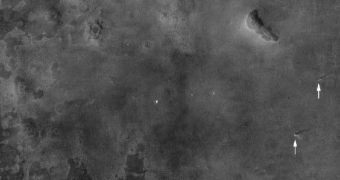NASA's Phoenix Mars lander is expected to touchdown on the Red Planet on May 25 in a north polar region known as "Green Valley". In anticipation for the event, NASA has been using its Mars Reconnaissance Orbiter to make periodical observations of the designated landing spot and on April 20, the MRO spotted two dust vortices - often called dust devils - towering one kilometer high into the Martian atmosphere, sweeping across a relatively flat patch of terrain.
In a thick atmosphere such as our own a vortex one kilometer high would most certainly spell disaster, but on Mars such phenomena rarely have any power at all. The two dust devils approximated to have been about 920 respectively 790 meters in height where spotted towards the center of the landing ellipse, an area inside the "Green Valley" measuring 20 by 100 kilometers, although they pose no danger to the success of the mission.
Similarly to those on Earth, Martian dust devils are created by atmospheric phenomena such as the rise of hot air, which also draws dust that reaches great heights in response to the low gravitational field exerted by the planet. "It's the low gravity and the fact that the surface gets warm and the energy is transferred into turbulence and uplift within the atmosphere", said Washington University and Phoenix team member Ray Arvidson.
Summer draws nearer
In fact these vortices are so weak that they draw more dust on the two Martian rovers, Spirit and Opportunity, than actually cleaning them in order to allow maximum sunlight to the solar panels. "If we're lucky, the occasional dust storm will help clear the dust off the deck and the solar panels", added Arvidson. The summer season is now closing in to the northern regions of the Red Planet, thus it is logical to believe that the dust devils will intensify in the coming months.
Dust devils have also been previously surprised on camera by Spirit and Phoenix could do as well since it will remain in the same place on the Green Valley for at least three months.
"The topography should be pretty flat looking off into the horizon, so the dust devils should be easy to spot", said Arvidson while revealing that in such a scenario the lander will be used to make a movie on the kilometer high phenomena. Instruments on board Phoenix are able to determine the size of dust particles as well as to understand solar radiation reaching the surface and "it would be good to have some dust devils moving through the area - both for science and cleanliness", he said.
Additionally, Phoenix will collect soil sample to make an analysis that would establish the past climate of the region and look for the presence of organic molecules or any other evidence of past existence of life.

 14 DAY TRIAL //
14 DAY TRIAL //